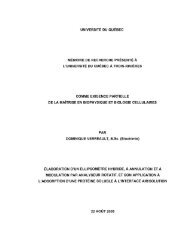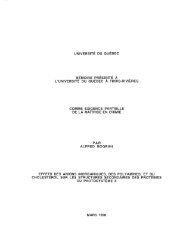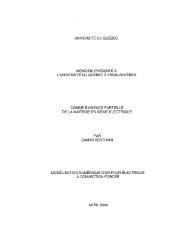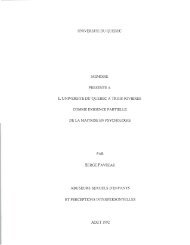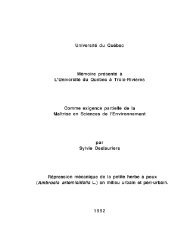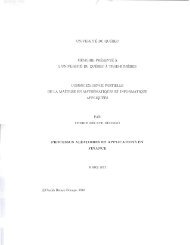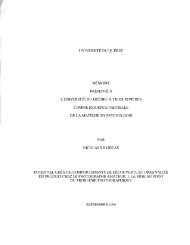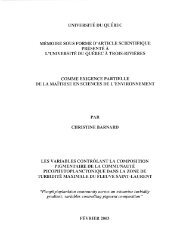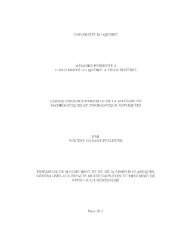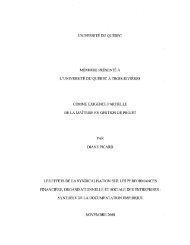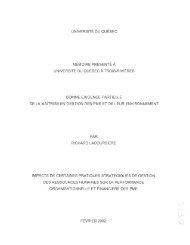- Page 1 and 2: UNIVERSITÉ DU QUÉBEC TIIÈSE PRÉ
- Page 3 and 4: À Denise, lafemme de ma vie. À Ma
- Page 5 and 6: anglo-protestante. De cet angle, le
- Page 7 and 8: d'accélérer le rythme de mes rech
- Page 9 and 10: CHAPITRE II - LE CADRE THÉORIQUE D
- Page 11 and 12: Premières compétitions officielle
- Page 13 and 14: Les championnats de curling, une co
- Page 15 and 16: Période 1960-1980 ................
- Page 17 and 18: Tableau 16: Ancienneté des clubs (
- Page 19 and 20: LISTE DES FIGURES Pages Figure 1: V
- Page 22 and 23: Durée d'un match: ensemble variabl
- Page 24 and 25: évolutions de longue durée de la
- Page 26: formation ou la disparition success
- Page 29 and 30: Lucien Febvre, l'idée est simpleme
- Page 31 and 32: sociologie de Simmel tourne résolu
- Page 33 and 34: sport moderne. De cette façon, les
- Page 35 and 36: un modèle inédit et en postulent
- Page 38 and 39: évocatrice. Nous adhérons à ce p
- Page 40 and 41: sportive et le code moral qui en d
- Page 42 and 43: Les principales divisions de la rec
- Page 44 and 45: CHAPITRE 1 UN SURVOL DE L'HISTORIOG
- Page 46 and 47: Toutefois, avant d'entrer dans le v
- Page 48 and 49: tournant des années 1860 que le sa
- Page 50 and 51: plus vaste échelle et ce, partout
- Page 54 and 55: travailleurs n'a d'existence signif
- Page 56 and 57: La présence des francophones au se
- Page 58 and 59: francophones au sein des premiers c
- Page 60 and 61: « dénonciations virulentes» les
- Page 62 and 63: golf, le tennis, le curling et le p
- Page 64 and 65: Howell: « It must he said that res
- Page 66 and 67: Les fondements du formalisme de Sim
- Page 68 and 69: diffuse d'un point limité vers l'i
- Page 70 and 71: Cette première analyse nous fait p
- Page 72 and 73: forme originelle du jeu. Fruit de l
- Page 74: forme ne ressemblant à une autre 2
- Page 77 and 78: L'objet de la sociologie Simmel nou
- Page 79 and 80: Que sont en fait, ces actions réci
- Page 81 and 82: La socialisation inclut l'idée d'u
- Page 83 and 84: crée alors la société. Si on ado
- Page 85 and 86: participants, « une même forme po
- Page 87 and 88: sociales, un réseau dynamique touj
- Page 89 and 90: La théorie du champ s'élabore amS
- Page 91 and 92: Cependant, le concept de configurat
- Page 93 and 94: section sur la pérennité des fonn
- Page 95 and 96: estées fidèles à des principes e
- Page 97: d'un quartier ou d'une ville qui co
- Page 100 and 101: ses aspirations 65 , l'individu tro
- Page 102 and 103:
détermination réelle dans l'espac
- Page 104 and 105:
Si la totalité des individus ou au
- Page 106 and 107:
qu'à penser au pouvoir évocateur
- Page 108 and 109:
L'honneur se situe à une position
- Page 110 and 111:
Ceux qui participent à la lutte co
- Page 112 and 113:
philosophique français. «Dans son
- Page 114 and 115:
entière à vivre en société. Ré
- Page 116:
ses premières études de la sociab
- Page 119 and 120:
tout à fait remarquable. En réfé
- Page 121 and 122:
ses principes associés. Par la sui
- Page 123 and 124:
101 L'exposé va se diviser en troi
- Page 125 and 126:
Tableau 1 L'intensité de la partic
- Page 127 and 128:
Pierre Arnaud l'exprime en ces term
- Page 129 and 130:
historique. De plus, à l'égard du
- Page 131:
109 Quelle est l'appartenance socia
- Page 134 and 135:
Valeurs La distinction Tableau 2 Va
- Page 136 and 137:
Les facteurs de l'institutionnalisa
- Page 138 and 139:
accessoire peut être le reflet d'u
- Page 140 and 141:
Et justement, après 1870, le tout
- Page 142 and 143:
club, des rapports annuels (Annuals
- Page 144 and 145:
sportif des quotidiens est moins im
- Page 146 and 147:
plus analytique autour des trois gr
- Page 148 and 149:
mise en évidence des faits et des
- Page 150 and 151:
Dans la deuxième moitié du chapit
- Page 154 and 155:
Figure 2 Le plumet de John Cairnie
- Page 156:
spécifique tandis que le balai éc
- Page 159:
des années 1860 que l'on voit s'é
- Page 163 and 164:
ils les premiers à l'avoir pratiqu
- Page 165 and 166:
égissant la société. Elle fourni
- Page 168 and 169:
Britanniques qui s'installent du c
- Page 170 and 171:
d'abord l'Écossais, les hommes d'a
- Page 172 and 173:
éfuter en rejoignant Robert W. Sim
- Page 174 and 175:
PREMIÈRE SOCIABILITÉ DU CURLING D
- Page 176 and 177:
Tableau 3 Les premières associatio
- Page 178:
d'Argenteuil, on fait état d'une p
- Page 182 and 183:
de Lévis. On pourrait spéculer su
- Page 184 and 185:
quelques motifs. Certes, il y avait
- Page 186 and 187:
nature du comportement social. Comm
- Page 188 and 189:
Cependant ce « nouveau» curling n
- Page 190 and 191:
plus grave, y aurait-il une fonne d
- Page 192:
L'absence est presque totale. Si, c
- Page 195 and 196:
le camp des Patriotes, mais très m
- Page 197 and 198:
dose de réalisme et de souplesse.
- Page 199 and 200:
Les sanctions, les procédures d'ex
- Page 201 and 202:
1847, révèlent que ces clubs main
- Page 203 and 204:
181 Nettement plus orientés vers l
- Page 205 and 206:
CHAPITRE V PRÉSENCES NOUVELLES SUR
- Page 207 and 208:
Comment l'autre communauté réagir
- Page 210 and 211:
188 Effectivement, la raquette est
- Page 212 and 213:
club réserve une compétition s'ad
- Page 214 and 215:
qu'aux messieurs. En 1903, 1 500 sp
- Page 216 and 217:
effectif moindre et une saison de j
- Page 218 and 219:
entre tous, de nommer le champion e
- Page 220 and 221:
progressivité de la compétition e
- Page 222 and 223:
populaire en curling au cours de ce
- Page 224:
possèdent cette particularité. Av
- Page 228 and 229:
qu'il a confiée à un éminent gé
- Page 230 and 231:
en reconnaissant l'importance du ba
- Page 232 and 233:
Figure 10 Intérieur du Montreal Cu
- Page 235 and 236:
fin d'un bout, la maIson entièreme
- Page 237:
ang et il profite des ressources et
- Page 240:
établissements. Il faut croire que
- Page 243 and 244:
donné une masse critique de citoye
- Page 245 and 246:
de créer une Ontario Branch 62 et,
- Page 247 and 248:
leurs compétitions apparaissent do
- Page 249 and 250:
227 À la toute fin de la saison, l
- Page 251 and 252:
Canadian Branch qui a orchestré le
- Page 253 and 254:
Des dispositions acquises de la bou
- Page 256 and 257:
Tableau 10 Cadre méthodologique An
- Page 258 and 259:
ne soit spécifiée à l'égard d'u
- Page 260 and 261:
1860 Figure 13 Répartition des cur
- Page 263 and 264:
Figure 15 Répartition des membres
- Page 265 and 266:
243 Le tableau 14 présente encore
- Page 267 and 268:
«The spirit of professionalism was
- Page 269 and 270:
seuls acteurs du curling, les immig
- Page 271 and 272:
Canadiens français. C'est du moins
- Page 273 and 274:
ne leur confèrent pas un meilleur
- Page 275 and 276:
son influence atteignent du même c
- Page 277 and 278:
255 adonner pendant la semaine, c'e
- Page 279 and 280:
La menace se pose avec plus d'acuit
- Page 281 and 282:
proportion passe de 5 à 15 % entre
- Page 283 and 284:
sa contrepartie anglophone. Le curl
- Page 285 and 286:
déjà 100 membres et va maintenir
- Page 287 and 288:
ooms at the disposal of the ladies
- Page 289 and 290:
267 Enfin, comment interpréter le
- Page 291 and 292:
pas que ce dernier passe aux mains
- Page 293 and 294:
philosophie anime les belligérants
- Page 296 and 297:
274 Malgré l'éloignement géograp
- Page 298 and 299:
Pérennité de la forme sociale Fig
- Page 300 and 301:
278 Le patrimoine une fois constitu
- Page 302 and 303:
Tableau 17 Renouvellement de l'effe
- Page 304 and 305:
282 Autre observation, entre 1870 e
- Page 306 and 307:
social au sein du foyer d'abord. À
- Page 308 and 309:
INTRODUCTION CHAPITRE VI L'ÂGE D'O
- Page 310 and 311:
francophones demeure toujours une p
- Page 312 and 313:
facteurs vont y contribuer : la mis
- Page 314 and 315:
confirmée une fois pour toutes dan
- Page 316 and 317:
championnat canadien de 1950 se dé
- Page 318 and 319:
296 Bien que les premières traces
- Page 321 and 322:
1946, il remporte le Royal Victoria
- Page 323 and 324:
eprennent leur suprématie au cours
- Page 325 and 326:
alors transférées d'un club à l'
- Page 327 and 328:
des cercles, et au début des anné
- Page 329 and 330:
ien que par temps très froid. Déc
- Page 331 and 332:
de ces accidents graves puisque les
- Page 333 and 334:
prévalent dans les clubs sont un p
- Page 335 and 336:
années 1940, l'élément de la con
- Page 337 and 338:
distinction particulière et ont é
- Page 339:
possible d'établir une comparaison
- Page 342 and 343:
masculinité trouve un lieu commun
- Page 344 and 345:
322 Bien qu'en 1920 le curling pouv
- Page 346:
curling représente 70 % de tous le
- Page 349 and 350:
Région Côte-Nord Nord-Ouest Mauri
- Page 351:
II) c 0 ;::; c CD E CD 'C ';le 100%
- Page 357 and 358:
par le magister catholique, les raq
- Page 359 and 360:
Incontestable, le décollage vérit
- Page 361:
véritable dans ce sport. Reprenant
- Page 364 and 365:
Toutefois, on a vu surgir ici et l
- Page 366 and 367:
En ville, la logique de création e
- Page 368 and 369:
complicité avec le monde des affai
- Page 370 and 371:
le premier ministre Taschereau est
- Page 372 and 373:
est vrai qu'à Montréal les quarti
- Page 374 and 375:
Une manière particulière de faire
- Page 376 and 377:
souvenir de très agréable facture
- Page 378 and 379:
356 En quelques lignes, que conclur
- Page 381 and 382:
société. Il ne saurait être ques
- Page 383 and 384:
compétition officielle mixte de la
- Page 385:
délibérations du club indiquent q
- Page 388 and 389:
Contrairement à un sport de masse
- Page 390:
la participation à la Grande Guerr
- Page 393 and 394:
Jacques-Cartier. Les articles trait
- Page 395 and 396:
373 Nos recherches indiquent d'abor
- Page 397 and 398:
au firmament du curling. L'addition
- Page 399 and 400:
à la promotion des pIerres, la Gra
- Page 401 and 402:
essentielles comme le loisir ou les
- Page 403 and 404:
modernité, l'établissement de nou
- Page 405 and 406:
383 Selon un traitement qui ne diff
- Page 407 and 408:
Tableau 22 Relevé des compétition
- Page 409 and 410:
387 La matérialisation de toutes c
- Page 411 and 412:
chapitre précédent l'a démontré
- Page 413 and 414:
(1979, 1980), ces équipes récolte
- Page 416 and 417:
l'influence du télévisuel est not
- Page 418 and 419:
poursuivre sa course au-delà de la
- Page 420 and 421:
tardivement. Lors du championnat mo
- Page 422 and 423:
facilitant l'achat de produits de c
- Page 424 and 425:
compétitions où il y avait obliga
- Page 426 and 427:
s'intéressa au sujet 41 et apporta
- Page 428 and 429:
systèmes de fabrication et de réf
- Page 430:
408 LE DÉCLIN DE POPULARITÉ DU CU
- Page 433 and 434:
conditions and viewpoints, we in th
- Page 435 and 436:
Les acteurs de cette vie associativ
- Page 437 and 438:
le gouvemement 59 • Ensuite, on s
- Page 439 and 440:
Tableau 23 Solde migratoire au Qué
- Page 441 and 442:
Branch se retrouve, une décennie p
- Page 443 and 444:
l'égard du milieu ouvrier et de to
- Page 445 and 446:
essentiellement le mérite d'être
- Page 447 and 448:
état de difficultés à concilier
- Page 449 and 450:
le statut des établissements en ta
- Page 451 and 452:
Changement de signification 429 Si
- Page 453 and 454:
431 Dans les grands centres de Qué
- Page 455 and 456:
433 Le second aspect examiné conce
- Page 457 and 458:
entrée tardivement. La compétitio
- Page 459 and 460:
Canadiens des méfaits de la cigare
- Page 462 and 463:
sombre colors are fast desapearing
- Page 464 and 465:
acceptent davantage de partager leu
- Page 466 and 467:
sociale de Québec durant une bonne
- Page 468 and 469:
play124 fait son entrée au Québec
- Page 470 and 471:
isque alors de conduire à un dése
- Page 472 and 473:
CONCLUSION 450 Indéniable que la p
- Page 474 and 475:
de Québec. Le rapport annuel'3' de
- Page 476 and 477:
grande équité entre les régions
- Page 478 and 479:
etard en curling par le fait que le
- Page 480 and 481:
qui persistent encore au début de
- Page 482 and 483:
dernières enclaves essentiellement
- Page 484 and 485:
462 Toutefois, s'il est une valeur
- Page 486 and 487:
fonne sociale et des facteurs qui e
- Page 489 and 490:
formes aussi disparates que l'Égli
- Page 491 and 492:
de normativité n'a réussi à endi
- Page 493 and 494:
Fonds personnels: Belnap, bonspiel
- Page 495 and 496:
Official Programfor the Visit of th
- Page 497 and 498:
475 Le Goff, Jacques, « L'Histoire
- Page 499 and 500:
Histoire 477 Marais, Jean-Luc, Les
- Page 501 and 502:
479 Hobsbawm, Eric, Nations et nati
- Page 503 and 504:
481 Boileau, Roger, Fernand Landry,
- Page 505 and 506:
Lavoie, Marc, Désavantage numériq
- Page 507 and 508:
485 Creelman, W. A, Curling. Past a
- Page 509 and 510:
487 Smith, David B., « The Intrigu
- Page 511 and 512:
confrontation. La Quebec Challenge
- Page 513 and 514:
Elle ne connaîtra plus qu'une autr
- Page 515 and 516:
MAAA Trophyll homme fers 1893 Quebe
- Page 517 and 518:
déroulée avec des pierres. Au cou
- Page 519 and 520:
Lord Elgin Quebec Challenge Cup Col
- Page 521 and 522:
inscrites, ce qui en fait l'événe
- Page 523 and 524:
de clubs locaux ne semblent en mesu
- Page 525 and 526:
elancent le club en 1820. Quelque d
- Page 527 and 528:
Somerville, James Allan, Sir Hugh A
- Page 529 and 530:
fondateur de la Province of Quebec
- Page 531 and 532:
aussi un vénérable serviteur du c
- Page 533 and 534:
Tableau 30 Autres personnalités ma
- Page 535 and 536:
engagement trouve un point de dépa
- Page 538 and 539:
Tableau 33 Autres personnalités ma
- Page 540 and 541:
Les perdants devraient payer le rep
- Page 542 and 543:
entre les deux villes. Et il Y eut
- Page 544 and 545:
522 «No party ever left Scotland,
- Page 546 and 547:
évérend Kerr à traduire les us e
- Page 548 and 549:
éception civique où le maire pren
- Page 550 and 551:
déplacement durant la guerre, la c
- Page 552 and 553:
aperçu du rythme d'activités que
- Page 554 and 555:
1972 Premier championnat provincial
- Page 556 and 557:
Le Brier de Québec en 1971, à deu
- Page 558 and 559:
Laurie Ross, une skip deux fois cha
- Page 560 and 561:
exceptionnelle de Jim Ursel. En eff
- Page 562 and 563:
journaliste Roland Sabourin se voit
- Page 564 and 565:
542 Cet épisode du curling vient c
- Page 566 and 567:
LOCALISATION DES CLUBS EN 1940 Côt
- Page 568 and 569:
KNOB LAKE (Schefferville) LABRIEVIL
- Page 570 and 571:
Nord-Ouest ll AMOS BELLETERRE CHIBO
- Page 572 and 573:
Période 1920-1960 ANNEXE V LES ORG
- Page 574 and 575:
de tenir ses compétitions officiel
- Page 576 and 577:
nombre au cours de ces années, les
- Page 578 and 579:
Ladies Curling Association Canadian
- Page 580 and 581:
de la toute nouvelle Fédération q
- Page 582 and 583:
identifié à la défunte Fédérat
- Page 584 and 585:
n'avait pas de déléguées présen
- Page 586 and 587:
ANNEXE VI LA PROCÉDURE DE L'ANALYS
- Page 588 and 589:
épandus, fréquents, plus l'échan
- Page 590 and 591:
seule colonne ne dépasse pas le ti



